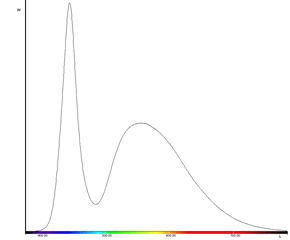DS-PRO LED Scuba Diving Lights are designated to professional and technical
divers who insist on a reliable and rugged lighting source. This is
the a new generation, using the world leader, Luxeon® K2 TFFC popower LEDs,
which bring additional features. Lamp head makes it possible to be
carried on the hand by Goodman holder, or on a helmet or on a
photo/video equipment arm.
Lamp parts are made from high quality
material which is sea water and sun resistant.
An array of seven LED lamps of the Philips Lumileds LUXEON® K2 typ with TFFC
technology offers the parameters second to none. The pictures below
show the HID versus white LED spectrum as measured in our lab. The
HID contains several spectral lines - peaks for several narrow bands -
colors while the rest is very weak. Although the human eye "sees"
the complex as white, some colors are missing, so when you liht on a
red object, it looks dark, or brown, for example. It is similar for
the green to blue range where the HID has a marked minimum.
Note that the white LED in fact is composed from a blue chip and a
wideband, yellow centered luminophore, the wider band the better.
 |
 |
| HID Light spectrum | LED Light spectrum (Cool White) |
The DS PRO LED can utilize two levels of light power, full (100%) and low, one-fifth power (20%). In the low power mode, just air cools the lamp sufficiently, so it will shine permanently at all conditions and the lamp will not overheat. At full power, the handpiece temperature rises if the lamp is not cooled and soon the temp sensor causes switching to low power. Low power also causes extending the lighting time by a factor of five. If, at full power, the battery becames almost empty, the status is indicated by four times switching between full and low power.
The intelligent lamp controller indicates the statuses by a two-digit LED display in the canister lid. Thanks to it, you know how long the lamp will shine, or how long the charging will take. The display also indicates possible problems inside the lamp and condition/temperature of each of the two batteries inside.
Integrated Smart Charging System implements advanced charging and cycling algorithms provided by the battery manufacturer. Thanks to it, maximum battery life and cycle number can be achieved, as well as shortest time for charging, under actual conditions. Second to none feature: no need to open the canister for charging: just plug the banana to smart isolated socket on canister top. Nothing to open and no risk of flooding the battery after incorrect re-closure.
The light beam radiation angle is selectable by installing the right
focusing (collimator) lens. Two values, ±6°(12°) a ±25° (50°)
of beam angle are available. While the wide beam is more suitable for
clear water, narrow beam fits better to "black" waters and to wreck
and cave diving.
Contrary to collimator, the reflector does not put all the light from
the source to the desired direction. Some part of the light is not
directed to desired direction. It may cause blinding of another diver
or disperse back in waters with poor visibility (dirt, plankton). It
is similar to high beam car lights in fog.
Using a collimator, most of light is directed forward almost
parallel, so the beam has greater intensity and the radiation pattern
has no side lobes, the diver can see further.